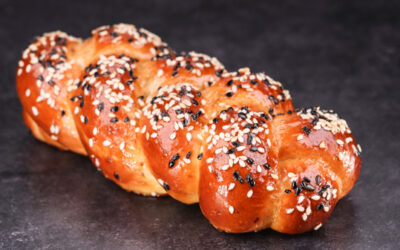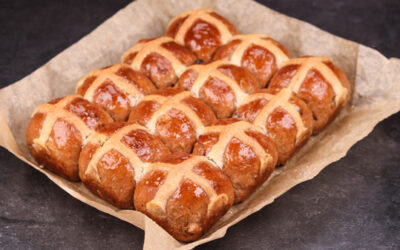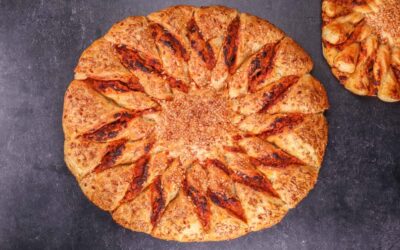Panettone is a delicious citrus flavoured Italian Christmas bread. It is soft and moist and full of flavour because of a long slow fermentation. I have made it extra easy by converting this classic to a no-knead version.
Loaded with lemon and orange zest it will fill your home with the most wonderful smell. But the smell is only one part of this delicious treat. Buttery soft texture and moist crumb filled with fruit and candied peel it is the ultimate Christmas loaf. Glazed with a nut and sugar glaze it comes out the oven with a crispy topping that may as well be my favourite part of it!
Panettone can be a hassle to make. Especially if you are mixing it by hand as the dough is extremely sticky and can be difficult to handle. This no-knead version relies on long cold proofing to develop structure and flavour.
Cold proofing allows for great flexibility when it comes to baking and mixing time. You can leave the dough in the fridge and forget it for a couple of days if you do not have time or your plans change. Or you can chill it for as little as 12 hours and continue with the next step.
Temperature control is not that strict in this recipe. Simply use room temperature ingredients and it will work fine. You can find the panettone cases in my Amazon shop linked below along with all the other equipment I use.
But if you are not into Italian Christmas breads, then do check out the Breads of Christmas playlist on my channel for many more awesome festive bread recipes from all over the World.
Watch the video down below for detailed instructions.
Ingredients
For the sponge (preferment) –
70g (2.5oz) strong white bread flour
70g (2.5oz) water
4g (0.14oz) instant dry yeast or 4.8g (0.16oz) active dry yeast or 12g (0.42oz) fresh yeast
For the 1st dough –
250g (8.8oz) strong white bread flour
60g (2.1oz) sugar
60g (2.1oz) soft butter
60g (2.1oz) water
60g (2.1oz) egg yolks
For the 2nd dough –
80g (2.8oz) strong white bread flour
60g (2.1oz) sugar
60g (2.1oz) egg yolks
20g (0.7oz) honey
100g (3.5oz) soft butter
7g (0.25oz) salt
60g (2.1oz) water
80g (2.8oz) raisins
80g (2.8oz) candied peel
60g (2.1oz) dried apricots
10g (0.35oz) vanilla syrup/paste/essence or half of a vanilla pod
Zest of two oranges
Zest of two lemons
For the glaze –
2 egg whites
40g (1.4oz) sugar
20g (0.7oz) almonds
20g (0.7oz) hazelnuts
5g (0.17oz) flour
3g (0.1oz) cocoa powder
*Blend to a smooth paste using a mixer or stick blender.
To decorate –
Almond halves
Sugar pearls
Method
- Make the sponge. In a large bowl combine the water, yeast, and flour. Mix until there is no dry flour left. Cover and ferment for 1 hour or until puffed up and bubbly.
- Make the first dough. Add the egg yolks, water, butter, and sugar to the sponge. Mix well to dissolve the sugar and break up the butter. Add the flour and mix well until there is no dry flour left. Scrape the dough together.
- Cover and cold proof for 12 – 24 hours. You can leave it in the fridge for up to 48 hours if you need/want to.
- Make the second dough. In a separate bowl combine the water, egg yolk, vanilla, honey, salt, sugar, lemon zest, and orange zest. Mix well to dissolve the salt and sugar. Add the butter and break it up into little chunks. Add the flour and mix until smooth. Add the dried fruit and candied peel. Mix again. All this mixing is there to distribute the ingredients evenly throughout the dough. Normally this would be achieved by kneading but we are not kneading so that is why it is important to do this in stages and in the right order.
- Add the second dough mix to the first dough. Squeeze the two doughs together by hand. Put in some elbow grease! Really go for it. It must come out between your fingers as you force it together. Keep mixing for a couple of minutes until the dough feels even and not lumpy.
- Scrape down the sides of the bowl. Cover and cold proof for 12 – 24 hours. Again, you could leave this in the fridge for up to 48 hours if need be.
- Shape the panettone. Dust the dough with flour generously because it will be sticky. Tip it out on the table smooth side down. Dust it with more flour. Cut in half and shape each half into a ball. Use more flour if it starts sticking.
- Place your dough balls in the moulds and press them to fit the shape.
- Final proof will take a long time and it will heavily depend on the temperature of your kitchen. You can place it in a warmer place to make it rise quicker or you can leave it on the table and forget about it. Mine took 18 hours to almost reach the top of the mould at 22C (72F). I starter fermenting it in the afternoon, and it was ready by the next morning. *During the final hour of fermentation preheat your oven to 160C (320F) fan on.
- Brush the loaves with the glaze. Be gentle and try not to poke them too much because they will be quite fragile at this point. Decorate with almonds and sugar pearls.
- Bake for 30 minutes. Cover with foil to prevent the top from darkening too much and bake for another 30 minutes. Leave to cool down completely. Ideally for 12 hours.
Enjoy your panettone or give it to someone as a gift. Happy baking!
Keep in mind that the conditions in each kitchen are different, so fermentation times may vary for you. It is up to the baker to control the bread and react accordingly.
Your oven may be different too, so your baking time may vary.
Watch the video here



